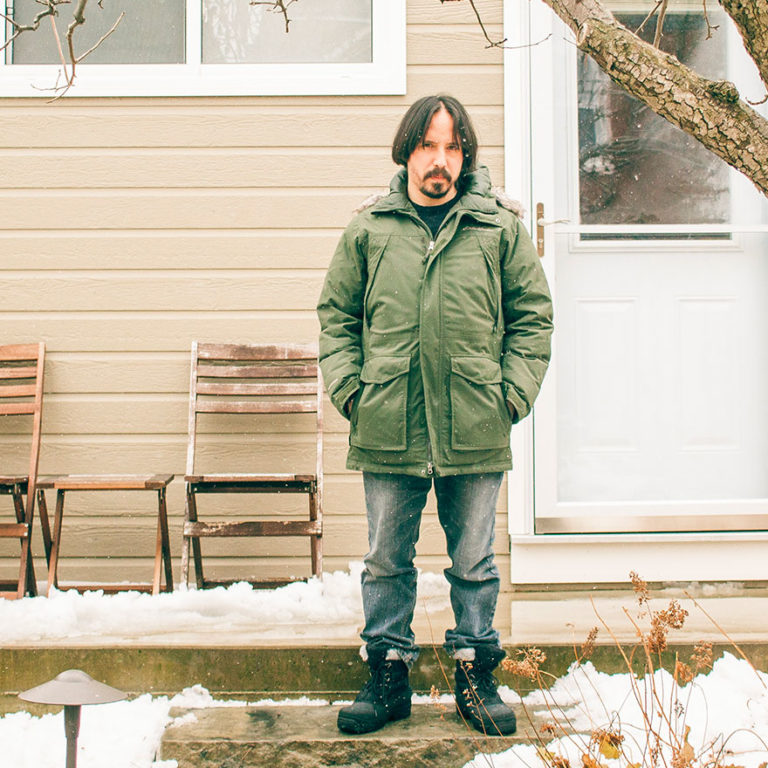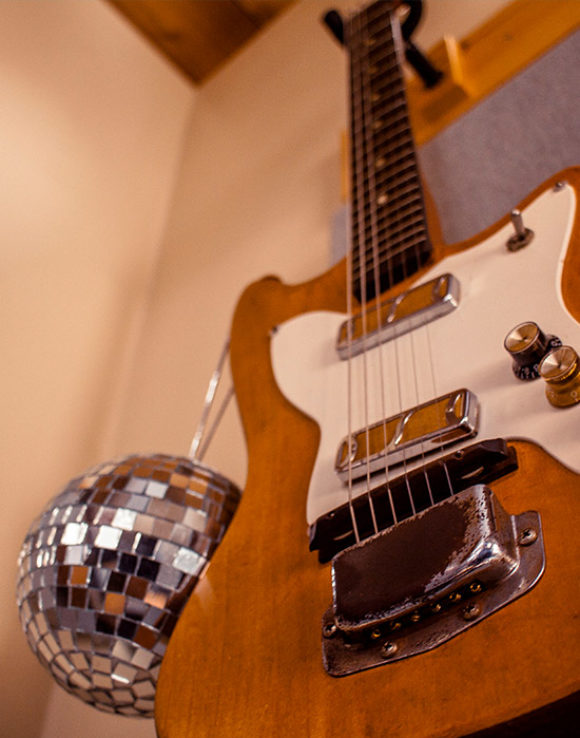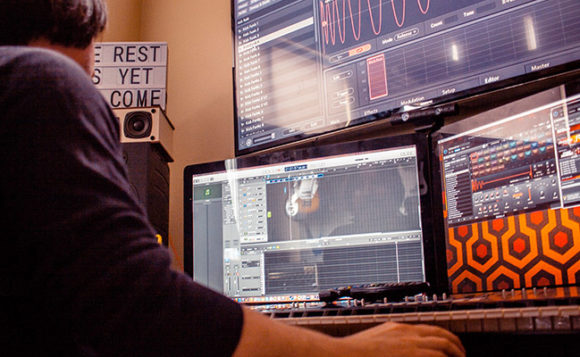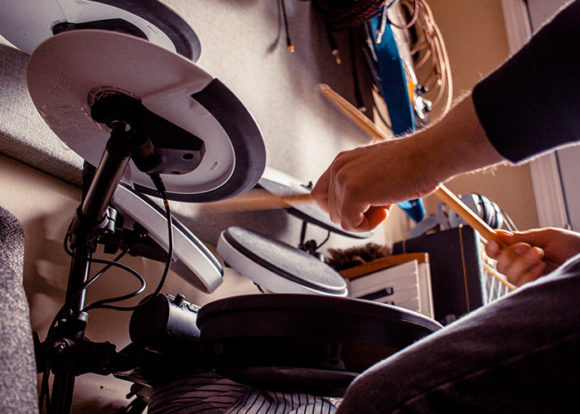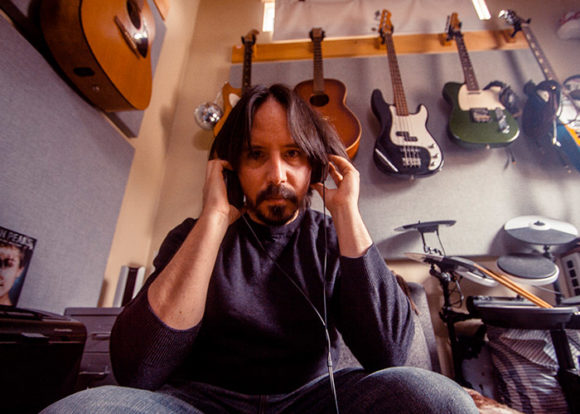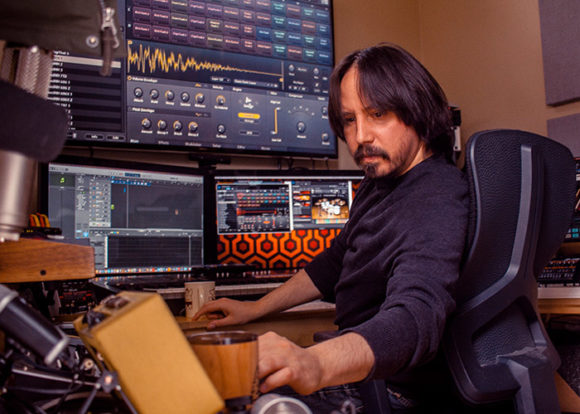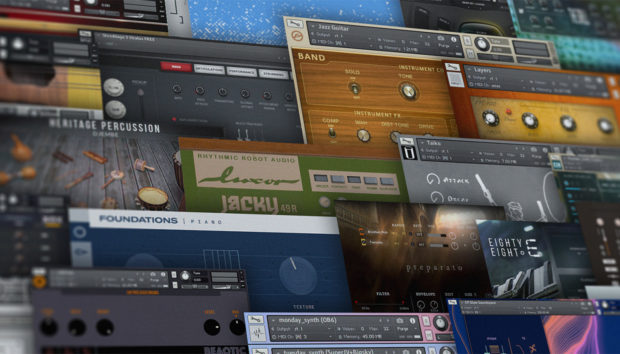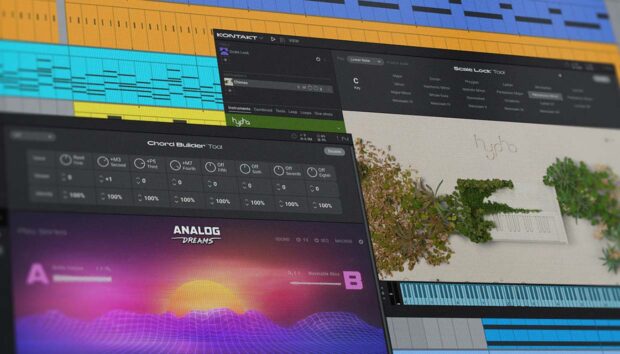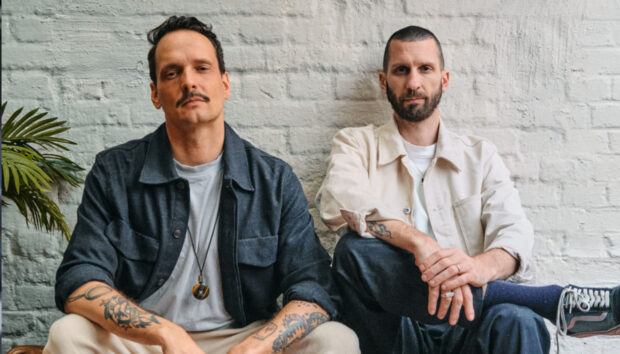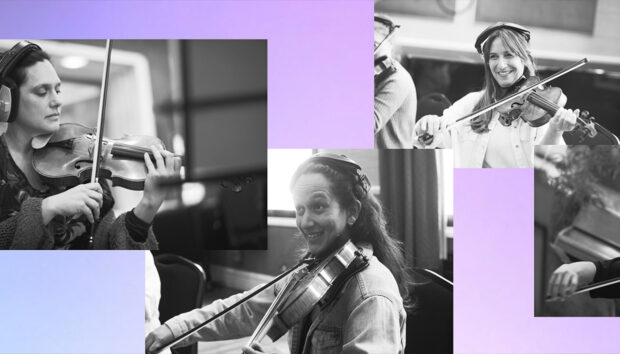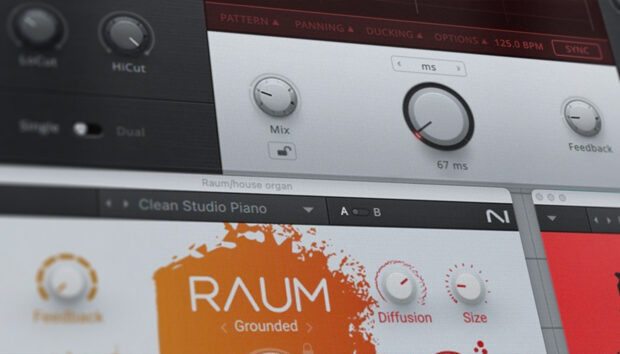Jim Guthrie is somewhat of an anomaly in the game music world: starting out by releasing a series of self-produced tapes in the nineties featuring his eccentric, lo-fi guitar playing, arrangements and singing, he later toured a bunch with several bands and released more music, for which he was eventually nominated for two Junos. He then made the lateral move of doing music for award winning film, TV, and more recently, video games, such as the critically acclaimed soundtrack for the game ‘Sword & Sworcery’. Jim might also be the first game music composer that you can jam with in-game! Writing on behalf of Native Instruments, Kabuki spoke with Jim to find out more about his philosophy and approach to making music.
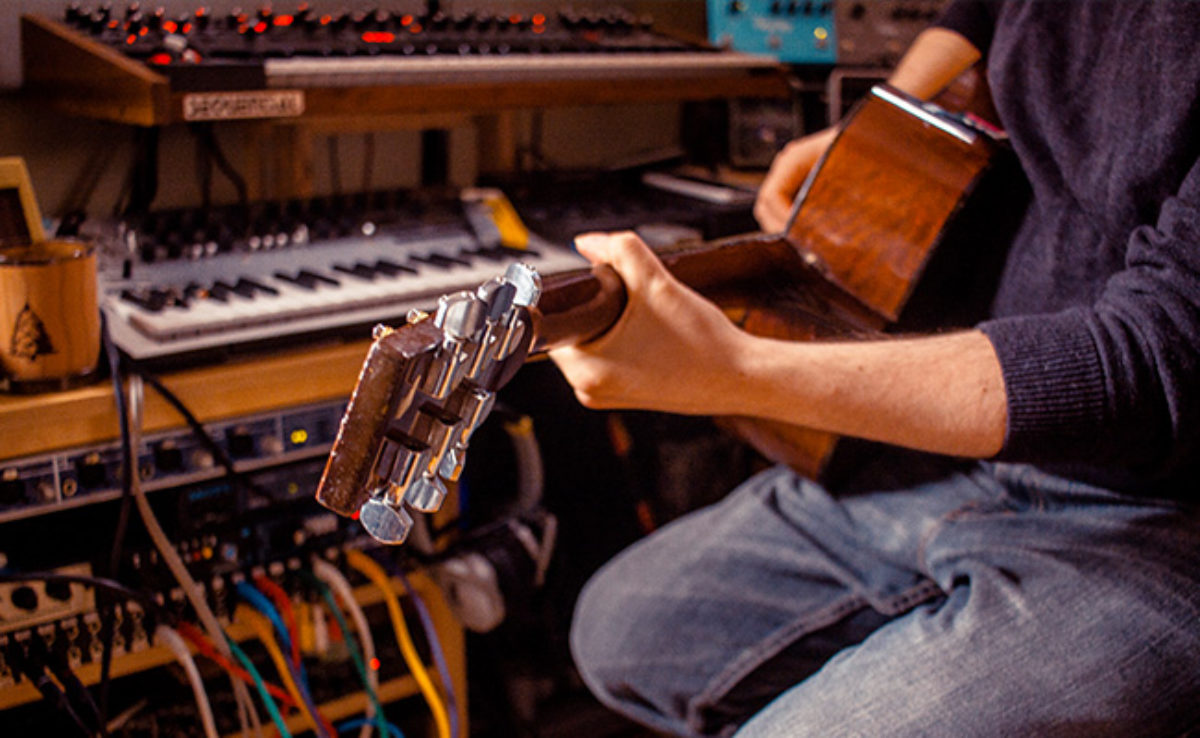
First of all, can you explain how you are making music at the moment?
Maybe I’ll start from the coolest aspect: I built a little shed studio in my backyard. It’s very tiny though, so I can almost touch both walls right now (laughs). I got a lot of hardware, like this old Akai 612 sampler which I love. It’s one of the first rack samplers ever made I think. And I have the keyboard that goes with it, which is the Akai AX60, so you could blend samples with the synth sounds and use the envelopes, filters and stuff from the keyboard to get some new sounds. I also have a bunch of pedals, like the Strymon BigSky and the TimeLine. Those are great, I love to put my synths through those before I go into my DAW.
You made the transition from being a guitarist and playing in bands to producing music for video games. How did you first get started in that aspect?
When I got into MIDI and tried to learn more about software and sample libraries and stuff, Native Instruments was one of the first names that came up when you did a search. I started with Komplete 6 and have been upgrading ever since. That was a big purchase for me back then, I wasn’t making any money, it was early days, right? I was also a latecomer, I didn’t own a computer until I was 25 or something.
What did you use before you had a computer?
I’ve been using the Fostex X-18 four track forever. I’m still using it today, I’ll record drones on separate tracks and then I’ll play the faders and put it through pedals. There’s just a smoothness, a beautiful thickness, that’s hard to get otherwise. A lot of times I create drones using the Electro Harmonix SuperEgo. You run a signal through it and hit the pedal, and it will grab a grain and stretch it out. So you put one note in, grab it, drone it, and then you can layer it with different sounds and build a chord. I’ll record that on track one, and then I’ll do another chord. You record that for half an hour on each track, rewind the tape, press play and just fade the drones in and out.
Check out “The First Day of Spring“ Jim wrote exclusively for Native Instruments:
How did you first start making music with the sequencer then?
My first method of making sequenced music was actually on a Playstation. I used this game called “MTV Music Generator”. A lot of stuff actually ended up on ‘Swords and Sworcery’.
Seriously?
Yeah, for probably five or six songs the sort of base track was rooted in this method, and then I would layer a bunch of other stuff in Logic. So that was my first kick at at computer music, this was all I could afford. Someone gave me the Playstation around ’96, and the game came with a magazine, you know it was one of those free demo discs. I was playing around with it at first, and when it came out six months later I bought it.
Does writing music on a workstation feel different to you?
The music you write on ‘MTV Music Generator’ would be totally different to how you would write on any other DAW. Like the music you make in Logic will be different to the music you write in Ableton. It’s almost like the software dictates part of your workflow, and you make different choices and things sound different because of the software and the interface. So in order for me to come up with new sounds, I like to learn new tools. I really feel that’s how you get out of your comfort zone, and how you learn to work with different limitations. Learn the quirks of different software or older gear, dig a little deeper.
Limitations can be a source for inspiration, right?
I always enjoyed limits. When I got my first computer I was overwhelmed, because there didn’t seem to be any limits compared to what I was used to. With the four-track or the Playstation, you know where the limits are, and you also know where to push. If there’s no line to cross then you can run wild forever and it’s easy to just waste a lot of time messing around. Limits force you to make a decision you might not make otherwise.
When you record your ideas to tape you have to live with them. But with the computer you can go back to the very genesis of a song and change something fundamental that makes the song fall apart.
Totally. I was always struggling with technology, but now I just really embrace it, and sort of like how crazy things are. I don’t feel paralyzed anymore. You know, like when I got Komplete for the first time, there was literally so much stuff and I had no idea how to use it. Because I had just grown out of being a guitar guy. But then I was like: “Man, I can do anything!”. You know, take something you wrote on a guitar, and use a plugin that you never messed with before, and then figure out how to transpose this little idea from the guitar over to a totally different sound. That was a really liberating experience.
So technology can also push the boundaries of what you thought is possible.
I remember how jungle pushed all the drummers to drum more crazy. When people started out with jungle, they created beats that were impossible for a human to play. But then humans practiced, and they would pitch their snares, learn how to play press rolls – I love how technology pushed people past what they thought they were capable of playing.
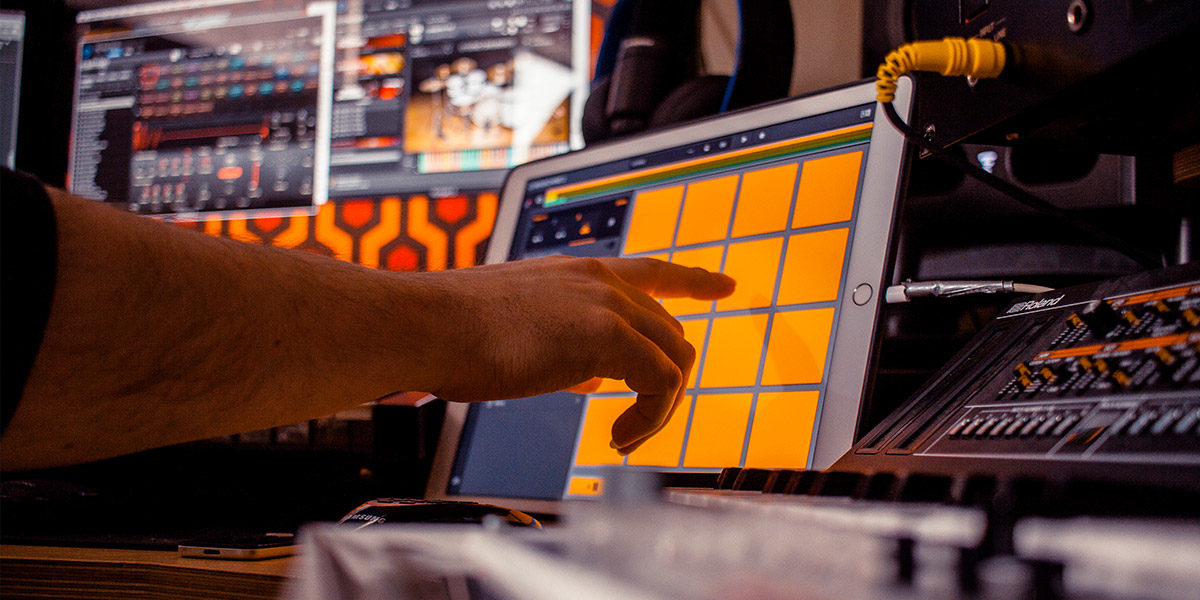
Talking of drums, did you record your own drums on the ‘Swords & Sworcery’ soundtrack, or were they sampled?
There were a couple of songs on there for which I recorded live drums on a four-track, and then I sampled them into the Playstation. And then there are other songs where I got into MIDI-drums. I’ve always recorded in the bedrooms and basements where I lived, so I didn’t have the luxury of getting a Led Zeppelin-esque sounding drum kit. But there are lots of cool libraries that you can buy that help with you that. Right now my shed is so small I got a Roland V Drum that folds into a suitcase. It’s the portable one, I forgot what the model is.
Any other must-have gear for you?
I guess a must-have for somebody like me is the OP1, a fantastic piece of gear. That one I love because I don’t know what the hell is going on half the time (laughs). They don’t label everything, you don’t know what variable you’re changing. Like there’s a squiggly line, and you turn a dial and the squiggly line turns into a straight line. If you use your ears though you can figure out which aspect of the sound you’re changing, and I like that because it’s abstract and it sort of forces you listen more.
Sometimes tools can get so overly technical that it’s easy to forget how much fun it can be to be creative, right?
Totally, and I think I’ve been lucky, because I’ve never been a gearhead. I mean, I love gear, but I’ve never known the names of microphones and preamps, because I always just tried to make as much music as I could. You know, the more time you spend worrying about the gear you use, and what the best mic is, that’s less time you actually spend using the shitty mic you already have. I love that quote: “The best camera is always the one you have on you“.
Do you have any tips on how to approach sound design?
I was always afraid to use a preset, so I would edit it to the point where it changed so much that it wasn’t the sound that I wanted anymore. So instead I really got into stacking preset sounds, combining basic sounds from the Kontakt library into something new. I try to keep it subtle though, like you know when you use reverb, and you turn it up so that you can just barely hear it and then dial it back again? I’ve been taking that same approach with stacking instruments. One technique that I use which goes against common knowledge is trying to find two to three sounds that are almost exact the same sounding in terms of timbre, attack, but together they will sound a little richer than on their own. It’s not trying to be this wild sound, because I still want to get a soft bell, but if you layer a couple of different bells, one is a little brighter, and has more low end in it, that creates an interesting result. Kontakt is my biggest asset for that, just using the sample editor and throwing in different sounds. I feel I’m always learning something new about Kontakt, that’s a big one for me.
photo credits: Phil Kim – ICON Motion








